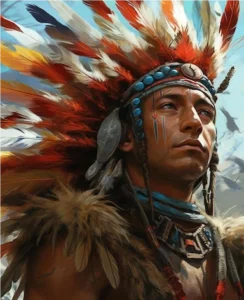
Why in news?
The President of India recently launched a National seminar spotlighting “Keonjhar’s Tribes: People, Culture and Heritage.”
culture and heritage of Keonjhar, Odisha
- Festivals in Keonjhar:
- Keonjhar, a district in Odisha, boasts a rich cultural tapestry woven with vibrant festivals observed throughout the year. These festivals, classified into domestic and public categories, offer a glimpse into the region’s diverse traditions.
- SARHUL:
- Celebrated in March-April, Sarhul is a tribal festival of flowers where sal flowers are brought to sacred groves, and prayers are offered to Mundas’ deities.
- The festivities span several days, resonating with cultural vibrancy.
- SOHRAI:
- In October-November, Sohrai is observed as Munda cattle owners fast for a day, lighting lamps at night, and performing rituals like washing cattle-sheds and feeding cattle generously the next morning.
- KARMAPUJA:
- The Karma Puja, celebrated predominantly by Adivasis in Keonjhar and Champua Sub-divisions, spans eight days in November-December.
- The culmination involves offerings to the presiding deity after a week of elaborate preparations and rituals.
- BODAM:
- Bodam, celebrated by all communities, precedes the consumption of new fruits. On a Thursday in the bright fortnight of Pousha, new fruits and flowers are collected, and a village-wide feast ensues, marked by fasting by select individuals.
- CHAITRA PARAB OR UDA PARAB:
- Observed on the last day of Chaitra for 3-4 days, Chaitra Parab involves worshiping goddess Basuli, with grand celebrations featuring Chhau dance performances in select areas.
- MAKARA SANKRANTI:
- Makara Sankranti, celebrated with holy dips in rivers and ponds, attracts large crowds to villages like Barhatipura and Deojhar, offering a festive ambiance to mark the end of the harvesting season.
- NUAKHAI:
- Nuakhai, translating to the ceremonial eating of new grains, involves collecting new paddy grains from households, offering them to the deity, and concluding with a communal feast and distribution of sanctified grains to villagers.
- RAJA PARAB:
- Raja, a significant agricultural festival, spans three days, featuring agricultural operations’ suspension, culinary delights, and cultural activities, with festivities concluding on Bhumidahan.
- BARUNI JATRA:
- Observed on the 13th day of the dark fortnight in Chaitra, Baruni Jatra attracts pilgrims to Gonasika for holy dips in the Brahma Kunda, symbolizing spiritual purification and cultural significance.
- RATHA JATRA:
- Similar to Puri Rath Jatra, the Gundicha Jatra in Keonjhar sees deities transported to Sri Gundicha mandira, engaging devotees in elaborate processions and religious fervor.
- SIVARATRI:
- Sivaratri, observed in Siva temples, involves night-long worship, lighting of lamps atop temples, and breaking of fast after seeing the Mahadipa, with grand celebrations at temples like Kusaleswar and Gonasika.
- Other Festivals:
- Ram Navami, Dasahara, Dola Jatra, Rahas Purnima, Bada Osha, and Chandan Jatra are among the other festivals celebrated with zest in Keonjhar, each adding its unique charm to the cultural mosaic.
- Folk Dances of Keonjhar:
- CHANGU DANCE:
- The Changu dance, popular among Bhuyans and other tribes, involves rhythmic movements accompanied by drumbeats, creating an enchanting spectacle of cultural expression.
- CHHAU DANCE:
- Chhau dance, known for its folkloric essence, combines dance and drama, originating from Mayurbhanj district, showcasing graceful footwork and powerful storytelling.
- JUANG DANCE:
- The Juang dance, accompanied by tambourines, epitomizes communal celebration, with men singing and girls dancing in sync, preserving age-old traditions.
- HO DANCE:
- The Ho tribe’s agricultural festivities include dances during the Magh festival, featuring spirited performances and liberating festivities, reflecting the tribe’s cultural ethos.
- CHANGU DANCE:
- Keonjhar’s vibrant culture and heritage, epitomized through its festivals and folk dances, serve as a testament to the region’s cultural resilience and community spirit, fostering unity and diversity amidst its scenic landscapes.
People also ask
Q1: What are the main festivals celebrated in Keonjhar?
Ans: Keonjhar hosts a plethora of festivals throughout the year, including Sarhul, Sohrai, Karmapuja, Bodam, Chaitra Parab, Makara Sankranti, Nuakhai, Raja Parab, Baruni Jatra, Rath Jatra, Sivaratri, among others.
Q2: What is the significance of Sarhul festival in Keonjhar?
Ans: Sarhul is a tribal festival of flowers celebrated in March-April, where sal flowers are brought to sacred groves to propitiate all gods of the Mundas, showcasing the community’s reverence for nature.
Q3: How do the people of Keonjhar observe Sohrai festival?
Ans: Sohrai, observed in October-November, entails Munda cattle owners fasting, lighting lamps at night, washing cattle-sheds, and feeding cattle abundantly the following morning, symbolizing gratitude towards livestock.
Q4: Can you elaborate on the Karmapuja festival celebrated in Keonjhar?
Ans: Karmapuja, primarily celebrated by Adivasis, spans eight days in November-December, involving rituals like collecting new pulses, planting branches of Karama tree, and culminating with offerings to the presiding deity, emphasizing community bonding and spiritual reverence.
Q5. What is the significance of Nuakhai festival in Keonjhar?
Ans: Nuakhai, meaning ceremonial eating of new grains, is observed in Bhadrab, where new paddy is collected, cooked into porridge, and offered to the Grama Devati, followed by communal feasting and distribution of sanctified grains, reflecting the agrarian heritage and communal harmony.
Thank you for your sharing. I am worried that I lack creative ideas. It is your article that makes me full of hope. Thank you. But, I have a question, can you help me?
I don’t think the title of your article matches the content lol. Just kidding, mainly because I had some doubts after reading the article. https://accounts.binance.info/en-IN/register?ref=UM6SMJM3
Thank you for your sharing. I am worried that I lack creative ideas. It is your article that makes me full of hope. Thank you. But, I have a question, can you help me?